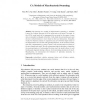Free Online Productivity Tools
i2Speak
i2Symbol
i2OCR
iTex2Img
iWeb2Print
iWeb2Shot
i2Type
iPdf2Split
iPdf2Merge
i2Bopomofo
i2Arabic
i2Style
i2Image
i2PDF
iLatex2Rtf
Sci2ools
ACRI
2006
Springer
2006
Springer
CA Models of Myxobacteria Swarming
We develop two models for Myxobacteria swarming, a modified Lattice Gas Cellular Automata (LGCA) model and an off-lattice CA model. In the LGCA model each cell is represented by one node for the center of mass and an extended rod-shaped cell profile. Cells check the surrounding area and choose in which direction to move based on the local interactions. Using this model, we obtained a density vs. expansion rate curve with the shape similar to the experimental curve for the wild type Myxobacteria. In the off-lattice model, each cell is represented by a string of nodes. Cells can bend and move freely in the two-dimensional space. We use a phenomenological algorithm to determine the moving direction of cells guided by slime trail; the model allows for cell bending and alignment during collisions. In the swarming simulations for A+SMyxobacteria, we demonstrate the formation of peninsula structures, in agreement with experiments.
| Added | 13 Jun 2010 |
| Updated | 13 Jun 2010 |
| Type | Conference |
| Year | 2006 |
| Where | ACRI |
| Authors | Yilin Wu, Nan Chen, Matthew Rissler, Yi Jiang, Dale Kaiser, Mark S. Alber |
Comments (0)

